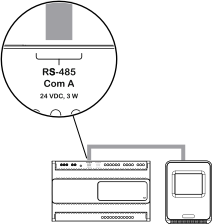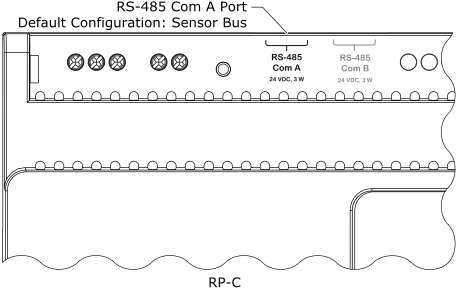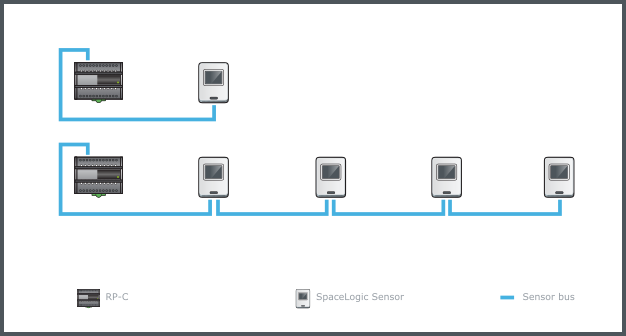
How to
Connecting SpaceLogic Sensor Devices to an RP-C Controller
You connect SpaceLogic Sensor devices to an RP-C controller to provide the devices with power and communication from the controller.
Install the SpaceLogic Sensor and connect a Cat 5 (or higher) unshielded, straight-through wired cable with eight conductors (four twisted pairs) to one of the two RJ45 receptacles on the sensor. Use a cable with the wire size (cross-sectional area) 22 to 26 AWG (0.34 to 0.14 mm²).
For more information, see SpaceLogic Sensors - SXWS Sensor Base - Installation Instructions .
For more information, see SpaceLogic Sensors - SXWS LCD Temperature Sensors - Installation Instructions .
Connect the other end of the cable to the RP-C controller's RS-485 port that is configured for the sensor bus.
Note:By default, the RS-485 Com A port is configured for the sensor bus.
action_zoom_plus_stroke 
When an additional SpaceLogic Sensor is needed, install the sensor and connect the other end of the cable to the unused RJ45 receptacle on the previous sensor.
Note:When connecting SpaceLogic Sensor devices to the sensor bus through a daisy-chain configuration, it does not matter if the incoming and outgoing cables are connected to one or the other sensor bus port on the SpaceLogic Sensor.
action_zoom_plus_stroke 
Repeat step 3 to install a third and fourth SpaceLogic Sensor.
Ensure that the two 2-position address DIP switches on each SpaceLogic Sensor are configured to give the sensor a unique address on the sensor bus.
For more information, see SpaceLogic Sensors - SXWS Sensor Base - Installation Instructions .
For more information, see SpaceLogic Sensors - SXWS LCD Temperature Sensors - Installation Instructions .
For more information, see Configuring a SpaceLogic Sensor .
 RP-C Controllers
RP-C Controllers
 RP-C Sensor Bus
RP-C Sensor Bus
 RP-C Communication Ports
RP-C Communication Ports
 SpaceLogic Sensor or MP Controller Sensor Bus Is Not Operational
SpaceLogic Sensor or MP Controller Sensor Bus Is Not Operational
 Configuring a SpaceLogic Sensor
Configuring a SpaceLogic Sensor

